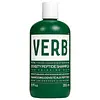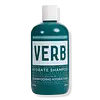What's inside
What's inside
 Key Ingredients
Key Ingredients

 Benefits
Benefits

 Concerns
Concerns

 Ingredients Side-by-side
Ingredients Side-by-side

Water
Skin ConditioningSodium C14-16 Olefin Sulfonate
CleansingCocamidopropyl Hydroxysultaine
CleansingSodium Lauroyl Methyl Isethionate
CleansingCocamidopropyl Betaine
CleansingPropanediol
SolventArgania Spinosa Kernel Oil
EmollientPanax Ginseng Root Extract
EmollientScutellaria Baicalensis Root Extract
AstringentGlycine Soja Germ Extract
EmollientTriticum Vulgare Germ Extract
Skin ConditioningBiotinoyl Tripeptide-1
Serenoa Serrulata Fruit Extract
Skin ConditioningVinegar
Niacinamide
SmoothingArginine
MaskingSodium Cocoyl Hydrolyzed Pea Protein
Glycerin
HumectantEthylhexylglycerin
Skin ConditioningPolyquaternium-73
Hydroxypropyl Starch Phosphate
Acrylates/Beheneth-25 Methacrylate Copolymer
Lactic Acid
BufferingTrisodium Ethylenediamine Disuccinate
Guar Hydroxypropyltrimonium Chloride
Skin ConditioningButylene Glycol
Humectant1,2-Hexanediol
Skin ConditioningCalcium Gluconate
HumectantGluconolactone
Skin ConditioningSodium Hydroxide
BufferingParfum
MaskingHydroxyacetophenone
AntioxidantSodium Benzoate
MaskingPhenoxyethanol
PreservativePotassium Sorbate
PreservativeLimonene
PerfumingHexyl Cinnamal
PerfumingLinalool
PerfumingLinalyl Acetate
MaskingWater, Sodium C14-16 Olefin Sulfonate, Cocamidopropyl Hydroxysultaine, Sodium Lauroyl Methyl Isethionate, Cocamidopropyl Betaine, Propanediol, Argania Spinosa Kernel Oil, Panax Ginseng Root Extract, Scutellaria Baicalensis Root Extract, Glycine Soja Germ Extract, Triticum Vulgare Germ Extract, Biotinoyl Tripeptide-1, Serenoa Serrulata Fruit Extract, Vinegar, Niacinamide, Arginine, Sodium Cocoyl Hydrolyzed Pea Protein, Glycerin, Ethylhexylglycerin, Polyquaternium-73, Hydroxypropyl Starch Phosphate, Acrylates/Beheneth-25 Methacrylate Copolymer, Lactic Acid, Trisodium Ethylenediamine Disuccinate, Guar Hydroxypropyltrimonium Chloride, Butylene Glycol, 1,2-Hexanediol, Calcium Gluconate, Gluconolactone, Sodium Hydroxide, Parfum, Hydroxyacetophenone, Sodium Benzoate, Phenoxyethanol, Potassium Sorbate, Limonene, Hexyl Cinnamal, Linalool, Linalyl Acetate
Water
Skin ConditioningSodium C14-16 Olefin Sulfonate
CleansingCocamide Mipa
EmulsifyingCocamidopropyl Hydroxysultaine
CleansingCocamidopropyl Betaine
CleansingAcrylates/Beheneth-25 Methacrylate Copolymer
Glycol Distearate
EmollientPyrus Malus Fruit Extract
Skin ConditioningArgania Spinosa Kernel Oil
EmollientOrbignya Oleifera Seed Oil
EmollientCeramide NP
Skin ConditioningSqualane
EmollientLauryl/Myristyl Polyricinoleate
EmollientEthylhexyl Olivate
Skin ConditioningEthylhexylglycerin
Skin ConditioningGlycerin
HumectantPolyquaternium-7
Parfum
MaskingSodium Lauroyl Sarcosinate
CleansingGuar Hydroxypropyltrimonium Chloride
Skin ConditioningAminomethyl Propanol
BufferingSodium Hydroxide
BufferingTrisodium Ethylenediamine Disuccinate
Citric Acid
BufferingSodium Benzoate
MaskingPhenoxyethanol
PreservativePotassium Sorbate
PreservativeBenzyl Salicylate
PerfumingWater, Sodium C14-16 Olefin Sulfonate, Cocamide Mipa, Cocamidopropyl Hydroxysultaine, Cocamidopropyl Betaine, Acrylates/Beheneth-25 Methacrylate Copolymer, Glycol Distearate, Pyrus Malus Fruit Extract, Argania Spinosa Kernel Oil, Orbignya Oleifera Seed Oil, Ceramide NP, Squalane, Lauryl/Myristyl Polyricinoleate, Ethylhexyl Olivate, Ethylhexylglycerin, Glycerin, Polyquaternium-7, Parfum, Sodium Lauroyl Sarcosinate, Guar Hydroxypropyltrimonium Chloride, Aminomethyl Propanol, Sodium Hydroxide, Trisodium Ethylenediamine Disuccinate, Citric Acid, Sodium Benzoate, Phenoxyethanol, Potassium Sorbate, Benzyl Salicylate
Ingredients Explained
These ingredients are found in both products.
Ingredients higher up in an ingredient list are typically present in a larger amount.
We don't have a description for Acrylates/Beheneth-25 Methacrylate Copolymer yet.
You may know this ingredient as argan oil. Argan Oil has antioxidant, hydrating, and soothing properties.
Studies have shown argan oil can help fight again radical damage from the sun. This makes it effective at preventing hyperpigmentation.
Large amounts of vitamin E found in argan oil helps the skin retain water. Argan oil also contains fatty acids such as linoleic acid, oleic acid, and palmitic acid. It is also a good source of lipids.
Another benefit of argan oil is skin-soothing. It can help reduce inflammation-related skin symptoms.
Argan Oil is effective at regulating sebum production in pores. This can make it effective at treating hormonal acne.
Traditionally, argan oil was used for its antibacterial and antifungal properties. However, argan oil contains fatty acids that may make it not fungal-acne safe.
Argan Trees are native to Morocco.
Learn more about Argania Spinosa Kernel OilCocamidopropyl Betaine is a fatty acid created by mixing similar compounds in coconut oil and dimethylaminopropylamine, a compound with two amino groups.
This ingredient is a surfactant and cleanser. It helps gather the dirt, pollutants, and other impurities in your skin to be washed away. It also helps thicken a product and make the texture more creamy.
Being created from coconut oil means Cocamidopropyl Betaine is hydrating for the skin.
While Cocamidopropyl Betaine was believed to be an allergen, a study from 2012 disproved this. It found two compounds in unpure Cocamidopropyl Betaine to be the irritants: aminoamide and 3-dimethylaminopropylamine. High-grade and pure Cocamidopropyl Betaine did not induce allergic reactions during this study.
Learn more about Cocamidopropyl BetaineCocamidopropyl Hydroxysultaine is a synthetic cleansing agent, though it is derived from coconut oil.
It is used to enhance the texture of products by boosting lather and thickening the texture. As a cleanser, Cocamidopropyl Hydroxysultaine is mild.
Ethylhexylglycerin (we can't pronounce this either) is commonly used as a preservative and skin softener. It is derived from glyceryl.
You might see Ethylhexylglycerin often paired with other preservatives such as phenoxyethanol. Ethylhexylglycerin has been found to increase the effectiveness of these other preservatives.
Glycerin is already naturally found in your skin. It helps moisturize and protect your skin.
A study from 2016 found glycerin to be more effective as a humectant than AHAs and hyaluronic acid.
As a humectant, it helps the skin stay hydrated by pulling moisture to your skin. The low molecular weight of glycerin allows it to pull moisture into the deeper layers of your skin.
Hydrated skin improves your skin barrier; Your skin barrier helps protect against irritants and bacteria.
Glycerin has also been found to have antimicrobial and antiviral properties. Due to these properties, glycerin is often used in wound and burn treatments.
In cosmetics, glycerin is usually derived from plants such as soybean or palm. However, it can also be sourced from animals, such as tallow or animal fat.
This ingredient is organic, colorless, odorless, and non-toxic.
Glycerin is the name for this ingredient in American English. British English uses Glycerol/Glycerine.
Learn more about GlycerinThis ingredient is derived from guar gum.
It is a conditioning ingredient, meaning it helps soften skin and hair.
Parfum is a catch-all term for an ingredient or more that is used to give a scent to products.
Also called "fragrance", this ingredient can be a blend of hundreds of chemicals or plant oils. This means every product with "fragrance" or "parfum" in the ingredients list is a different mixture.
For instance, Habanolide is a proprietary trade name for a specific aroma chemical. When used as a fragrance ingredient in cosmetics, most aroma chemicals fall under the broad labeling category of “FRAGRANCE” or “PARFUM” according to EU and US regulations.
The term 'parfum' or 'fragrance' is not regulated in many countries. In many cases, it is up to the brand to define this term.
For instance, many brands choose to label themselves as "fragrance-free" because they are not using synthetic fragrances. However, their products may still contain ingredients such as essential oils that are considered a fragrance by INCI standards.
One example is Calendula flower extract. Calendula is an essential oil that still imparts a scent or 'fragrance'.
Depending on the blend, the ingredients in the mixture can cause allergies and sensitivities on the skin. Some ingredients that are known EU allergens include linalool and citronellol.
Parfum can also be used to mask or cover an unpleasant scent.
The bottom line is: not all fragrances/parfum/ingredients are created equally. If you are worried about fragrances, we recommend taking a closer look at an ingredient. And of course, we always recommend speaking with a professional.
Learn more about ParfumPhenoxyethanol is a preservative that has germicide, antimicrobial, and aromatic properties. Studies show that phenoxyethanol can prevent microbial growth. By itself, it has a scent that is similar to that of a rose.
It's often used in formulations along with Caprylyl Glycol to preserve the shelf life of products.
Potassium Sorbate is a preservative used to prevent yeast and mold in products. It is commonly found in both cosmetic and food products.
This ingredient comes from potassium salt derived from sorbic acid. Sorbic acid is a natural antibiotic and effective against fungus.
Both potassium sorbate and sorbic acid can be found in baked goods, cheeses, dried meats, dried fruit, ice cream, pickles, wine, yogurt, and more.
You'll often find this ingredient used with other preservatives.
Learn more about Potassium SorbateSodium Benzoate is a preservative. It's used in both cosmetic and food products to inhibit the growth of mold and bacteria. It is typically produced synthetically.
Both the US FDA and EU Health Committee have approved the use of sodium benzoate. In the US, levels of 0.1% (of the total product) are allowed.
Sodium benzoate works as a preservative by inhibiting the growth of bacteria inside of cells. It prevents the cell from fermenting a type of sugar using an enzyme called phosphofructokinase.
It is the salt of benzoic acid. Foods containing sodium benzoate include soda, salad dressings, condiments, fruit juices, wines, and snack foods.
Studies for using ascorbic acid and sodium benzoate in cosmetics are lacking, especially in skincare routines with multiple steps.
We always recommend speaking with a professional, such as a dermatologist, if you have any concerns.
Learn more about Sodium BenzoateSodium C14-16 Olefin Sulfonate is a cleansing agent made from a mixture of long chain sulfonate salts. It can also help produce foam.
This ingredient may be drying. We recommend speaking with a professional if you have concerns.
Sodium Hydroxide is also known as lye or caustic soda. It is used to adjust the pH of products; many ingredients require a specific pH to be effective.
In small amounts, sodium hydroxide is considered safe to use. However, large amounts may cause chemical burns due to its high alkaline.
Your skin has a natural pH and acid mantle. This acid mantle helps prevent harmful bacteria from breaking through. The acid mantle also helps keep your skin hydrated.
"Alkaline" refers to a high pH level. A low pH level would be considered acidic.
Learn more about Sodium HydroxideTrisodium Ethylenediamine Disuccinate is used to help stabilize a product.
It is a chelating agent, meaning it helps prevent metal ions from binding to other ingredients. This prevents unwanted reactions in products. Metal ions can come into a product via the water ingredient. They are found in trace amounts and are not known to be harmful.
Water. It's the most common cosmetic ingredient of all. You'll usually see it at the top of ingredient lists, meaning that it makes up the largest part of the product.
So why is it so popular? Water most often acts as a solvent - this means that it helps dissolve other ingredients into the formulation.
You'll also recognize water as that liquid we all need to stay alive. If you see this, drink a glass of water. Stay hydrated!
Learn more about Water